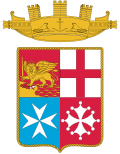 Carabiniere (F 581) | |
| Class overview | |
|---|---|
| Name | Alpino class |
| Builders | Cantieri Navali Riuniti (CNR) |
| Operators | |
| Preceded by | Bergamini class |
| Succeeded by | Lupo class |
| In service | 1963–68 |
| In commission | 1968–97 |
| Planned | 4 |
| Completed | 2 |
| Canceled | 2 |
| Retired | 2 |
| General characteristics [1] | |
| Type | Frigate |
| Displacement | |
| Length | 113.30 m (371 ft 9 in) |
| Beam | 13.10 m (43 ft 0 in) |
| Draught | 3.8 m (12 ft 6 in) |
| Propulsion |
|
| Speed |
|
| Range | 3,500 nmi (6,500 km; 4,000 mi) at 18 knots (33 km/h; 21 mph) (diesels) |
| Complement | 263 |
| Sensors & processing systems | |
| Electronic warfare & decoys | SLQ-D ECM system |
| Armament |
|
| Aircraft carried | 2 × AB-204 [2] or AB-212ASW [3] helicopters |
| Aviation facilities | Telescopic hangar for 2 medium helicopters. |
The Alpino class were a group of two frigates built for the Italian Navy during the Cold War.
